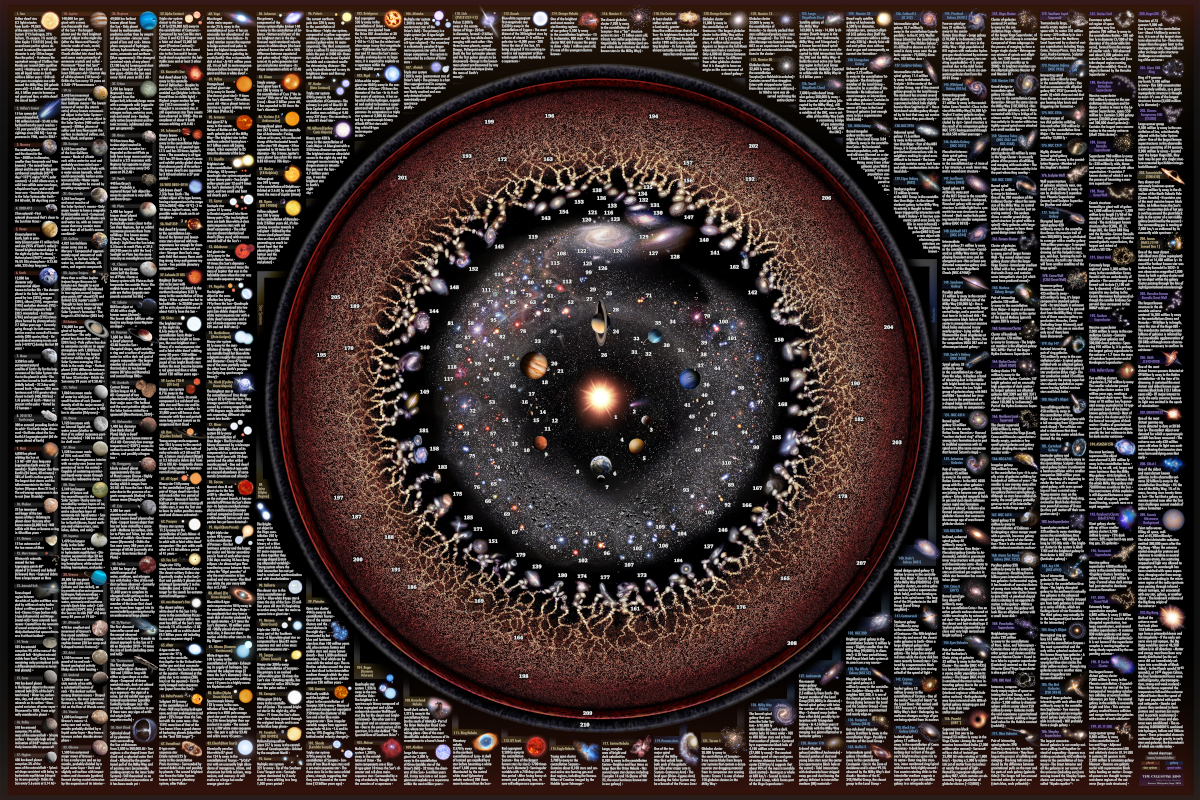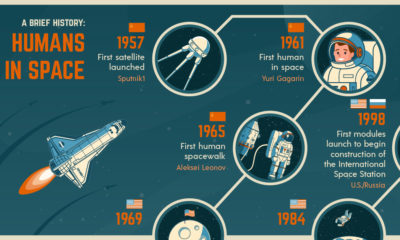Space
The Celestial Zoo: A Map of 200+ Objects in Our Universe
View the full-size infographic
View a larger version of this graphic. For a full-size option or to inquire about posters, please visit Pablo Carlos Budassi’s website.
The Celestial Zoo: A Map of 200+ Objects in our Universe
Humans have been observing the universe for thousands of years.
And while we haven’t figured out all the answers quite yet, we’ve made some remarkable discoveries when it comes to learning about outer space.
What are some of the most notable observations that scientists have discovered so far? This map of outer space by Pablo Carlos Budassi highlights more than 200 celestial objects in our universe and provides details and facts about each one.
The Types of Celestial Objects Mapped
To create this graphic, Budassi used a combination of logarithmic astronomical maps from Princeton University, as well as images from NASA.
The visualization highlights 216 different celestial objects that are color-coded and organized into five overarching categories:
- Moons and Asteroids
- Planets
- Galaxies
- Star System
- Great Scales/Superclusters
At the center of the map is the Sun, which is the largest object in our Solar System. According to NASA, the Sun’s volume is equivalent to 1.3 million Earths. The Sun is the powerhouse of life here on Earth—its energy provides our planet with a mild, warm climate that keeps us alive, keeping the Earth from becoming a frozen rock.
While the Sun is the only star in the Solar System, there is a neighboring star system called Alpha Centauri that’s approximately 4.37 light-years away. It’s made up of three stars—Proxima Centauri, Alpha Centauri A, and Alpha Centauri B.
Proxima Centauri, as the Latin name indicates, is the closest of the three to Earth and has an Earth-sized planet in its habitable zone.
The Life of a Star
In a star’s early stages, it’s powered by hydrogen. However, when its hydrogen stores are depleted, some stars are able to fuse helium or even heavier elements.
Stars similar to the size of the Sun will grow, cool down, and eventually transform into a red giant. The Sun has about 5,000 million more years before it reaches its red giant stage, but when that happens, it will likely expand to the point where it swallows up the Earth.
While stars emit energy for years, it’s important to note that they don’t shine for eternity. Their exact life span depends on their size, with bigger stars burning out faster than their smaller counterparts.
But as light from distant objects millions of light-years away takes a long time to reach us here on Earth, the largest of stars shine for hundreds of millions of years after they die.
Just How Big is Our Universe?
Some experts believe that the universe is infinite, while others argue that we can’t yet know for certain because current measurements aren’t accurate enough.
However, scientists believe that our observable universe extends about 46 billion light-years in every direction, giving it a diameter of roughly 93 billion light-years.
But just how much of the universe extends beyond what we can see? We may never find out.

This article was published as a part of Visual Capitalist's Creator Program, which features data-driven visuals from some of our favorite Creators around the world.
Technology
Which Companies Own the Most Satellites?
Despite Starlink’s dominance in the industry, the company is set to face intense competition in the coming years.

Which Companies Own the Most Satellites?
Nearly 7,000 satellites orbit the Earth, serving vital functions such as communication, navigation, and scientific research.
In 2022 alone, more than 150 launches took place, sending new instruments into space, with many more expected over the next decade.
But who owns these objects? In this graphic, we utilize data from the Union of Concerned Scientists to highlight the leaders in satellite technology.
SpaceX’s Dominance in Space
SpaceX, led by Elon Musk, is unquestionably the industry leader, currently operating the largest fleet of satellites in orbit—about 50% of the global total.
The company has already completed 62 missions this year, surpassing any other company or nation, and operates thousands of internet-beaming Starlink spacecraft that provide global internet connectivity.
Starlink customers receive a small satellite dish that self-orients itself to align with Starlink’s low-Earth-orbit satellites.
| Owner | Total | Share | Country |
|---|---|---|---|
| SpaceX | 3,395 | 50% | USA |
| OneWeb Satellites | 502 | 7% | UK |
| Chinese Government | 369 | 5% | China |
| U.S. Government | 306 | 4% | USA |
| Planet Labs, Inc. | 195 | 3% | USA |
| Russian Federation | 137 | 2% | Russia |
| Spire Global Inc. | 127 | 2% | USA |
| Swarm Technologies | 84 | 1% | USA |
| Iridium Communications, Inc. | 75 | 1% | USA |
| Other | 1,528 | 23% |
Percentages may not add to 100 due to rounding.
In second place is a lesser-known company, British OneWeb Satellites. The company, headquartered in London, counts the UK government among its investors and provides high-speed internet services to governments, businesses, and communities.
Like many other satellite operators, OneWeb relies on SpaceX to launch its satellites.
Despite Starlink’s dominance in the industry, the company is set to face intense competition in the coming years. Amazon’s Project Kuiper plans to deploy 3,236 satellites by 2029 to compete with SpaceX’s network. The first of the fleet could launch as early as 2024.
The Rise of China’s Space Program
After the top private companies, governments also own a significant portion of satellites orbiting the Earth. The U.S. remains the leader in total satellites, when adding those owned by both companies and government agencies together.
American expenditures on space programs reached $62 billion in 2022, five times more than the second one, China.
China, however, has sped up its space program over the last 20 years and currently has the highest number of satellites in orbit belonging directly to government agencies. Most of these are used for Earth observation, communications, defense, and technology development.
Satellite Demand to Rise Over the Decade
Despite the internet being taken for granted in major metropolitan areas and developed countries, one out of every three people worldwide has never used the web.
Furthermore, the increasing demand for data and the emergence of new, more cost-effective satellite technologies are expected to present significant opportunities for private space companies.
In this context, satellite demand is projected to quadruple over the next decade.
-

 Real Estate2 weeks ago
Real Estate2 weeks agoVisualizing America’s Shortage of Affordable Homes
-

 Technology1 week ago
Technology1 week agoRanked: Semiconductor Companies by Industry Revenue Share
-

 Money1 week ago
Money1 week agoWhich States Have the Highest Minimum Wage in America?
-

 Real Estate1 week ago
Real Estate1 week agoRanked: The Most Valuable Housing Markets in America
-

 Business2 weeks ago
Business2 weeks agoCharted: Big Four Market Share by S&P 500 Audits
-

 AI2 weeks ago
AI2 weeks agoThe Stock Performance of U.S. Chipmakers So Far in 2024
-

 Misc2 weeks ago
Misc2 weeks agoAlmost Every EV Stock is Down After Q1 2024
-

 Money2 weeks ago
Money2 weeks agoWhere Does One U.S. Tax Dollar Go?










